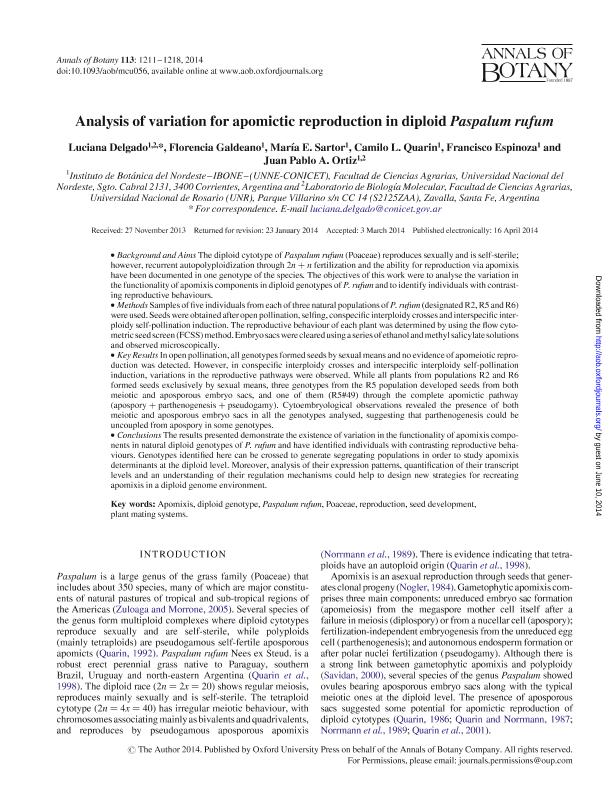Artículo
Analysis of variation for apomictic reproduction in diploid Paspalum rufum
Delgado Benarroch, Luciana ; Galdeano, Florencia
; Galdeano, Florencia ; Sartor, Maria Esperanza
; Sartor, Maria Esperanza ; Quarin, Camilo Luis
; Quarin, Camilo Luis ; Espinoza, Francisco
; Espinoza, Francisco ; Ortiz, Juan Pablo Amelio
; Ortiz, Juan Pablo Amelio
 ; Galdeano, Florencia
; Galdeano, Florencia ; Sartor, Maria Esperanza
; Sartor, Maria Esperanza ; Quarin, Camilo Luis
; Quarin, Camilo Luis ; Espinoza, Francisco
; Espinoza, Francisco ; Ortiz, Juan Pablo Amelio
; Ortiz, Juan Pablo Amelio
Fecha de publicación:
06/2014
Editorial:
Oxford University Press
Revista:
Annals of Botany
ISSN:
0305-7364
e-ISSN:
1095-8290
Idioma:
Inglés
Tipo de recurso:
Artículo publicado
Clasificación temática:
Resumen
Background and Aims: The diploid cytotype of Paspalum rufum (Poaceae) reproduces sexually and is self-sterile; however, recurrent autopolyploidization through 2n + n fertilization and the ability for reproduction via apomixis have been documented in one genotype of the species. The objectives of this work were to analyse the variation in the functionality of apomixis components in diploid genotypes of P. rufum and to identify individuals with contrasting reproductive behaviours. Methods: Samples of five individuals from each of three natural populations of P. rufum (designated R2, R5 and R6) were used. Seeds were obtained after open pollination, selfing, conspecific interploidy crosses and interspecific interploidy self-pollination induction. The reproductive behaviour of each plant was determined by using the flow cytometric seed screen (FCSS) method. Embryo sacs were cleared using a series of ethanol and methyl salicylate solutions and observed microscopically. Key Results: In open pollination, all genotypes formed seeds by sexual means and no evidence of apomeiotic reproduction was detected. However, in conspecific interploidy crosses and interspecific interploidy self-pollination induction, variations in the reproductive pathways were observed. While all plants from populations R2 and R6 formed seeds exclusively by sexual means, three genotypes from the R5 population developed seeds from both meiotic and aposporous embryo sacs, and one of them (R5#49) through the complete apomictic pathway (apospory + parthenogenesis + pseudogamy). Cytoembryological observations revealed the presence of both meiotic and aposporous embryo sacs in all the genotypes analysed, suggesting that parthenogenesis could be uncoupled from apospory in some genotypes. Conclusions: The results presented demonstrate the existence of variation in the functionality of apomixis components in natural diploid genotypes of P. rufum and have identified individuals with contrasting reproductive behaviours. Genotypes identified here can be crossed to generate segregating populations in order to study apomixis determinants at the diploid level. Moreover, analysis of their expression patterns, quantification of their transcript levels and an understanding of their regulation mechanisms could help to design new strategies for recreating apomixis in a diploid genome environment.
Archivos asociados
Licencia
Identificadores
Colecciones
Articulos(CCT - ROSARIO)
Articulos de CTRO.CIENTIFICO TECNOL.CONICET - ROSARIO
Articulos de CTRO.CIENTIFICO TECNOL.CONICET - ROSARIO
Articulos(IBONE)
Articulos de INST.DE BOTANICA DEL NORDESTE (I)
Articulos de INST.DE BOTANICA DEL NORDESTE (I)
Citación
Delgado Benarroch, Luciana; Galdeano, Florencia; Sartor, Maria Esperanza; Quarin, Camilo Luis; Espinoza, Francisco; et al.; Analysis of variation for apomictic reproduction in diploid Paspalum rufum; Oxford University Press; Annals of Botany; 113; 7; 6-2014; 1211-1218
Compartir
Altmétricas



